Phát triển vốn từ vựng cho sinh viên năm 3 - khoa cơ điện - điện tử, trường Đại học Lạc Hồng
Nghiên cứu này nhằm mục đích tìm hiểu xem việc đọc mở rộng có thể giúp sinh viên đại học phát triển vốn từ
vựng hay không. Hai nhóm đối tượng đã tham gia nghiên cứu - nhóm kiểm nghiệm đã đọc nhiều tài liệu thêm bên ngoài được
nhóm tác giả lựa chọn cẩn thận (95 phút cho các hoạt động trong lớp và 40 phút để đọc mở rộng) trong khoảng thời gian 10
tuần và nhóm đối chứng chỉ tiếp thu các hoạt động đọc trên lớp. Kết quả nghiên cứu được thu thập từ ba phương pháp: làm
bài kiểm tra, quan sát và phỏng vấn để đánh giá mức độ tăng vốn từ vựng của hai nhóm tham gia và đã cho thấy sự cải thiện
về từ vựng của cả hai nhóm. Tuy nhiên, nhóm kiểm nghiệm đã sử dụng được đa dạng vốn từ vựng trong các kỹ năng viết,
nói và đọc tốt hơn nhóm đối chứng
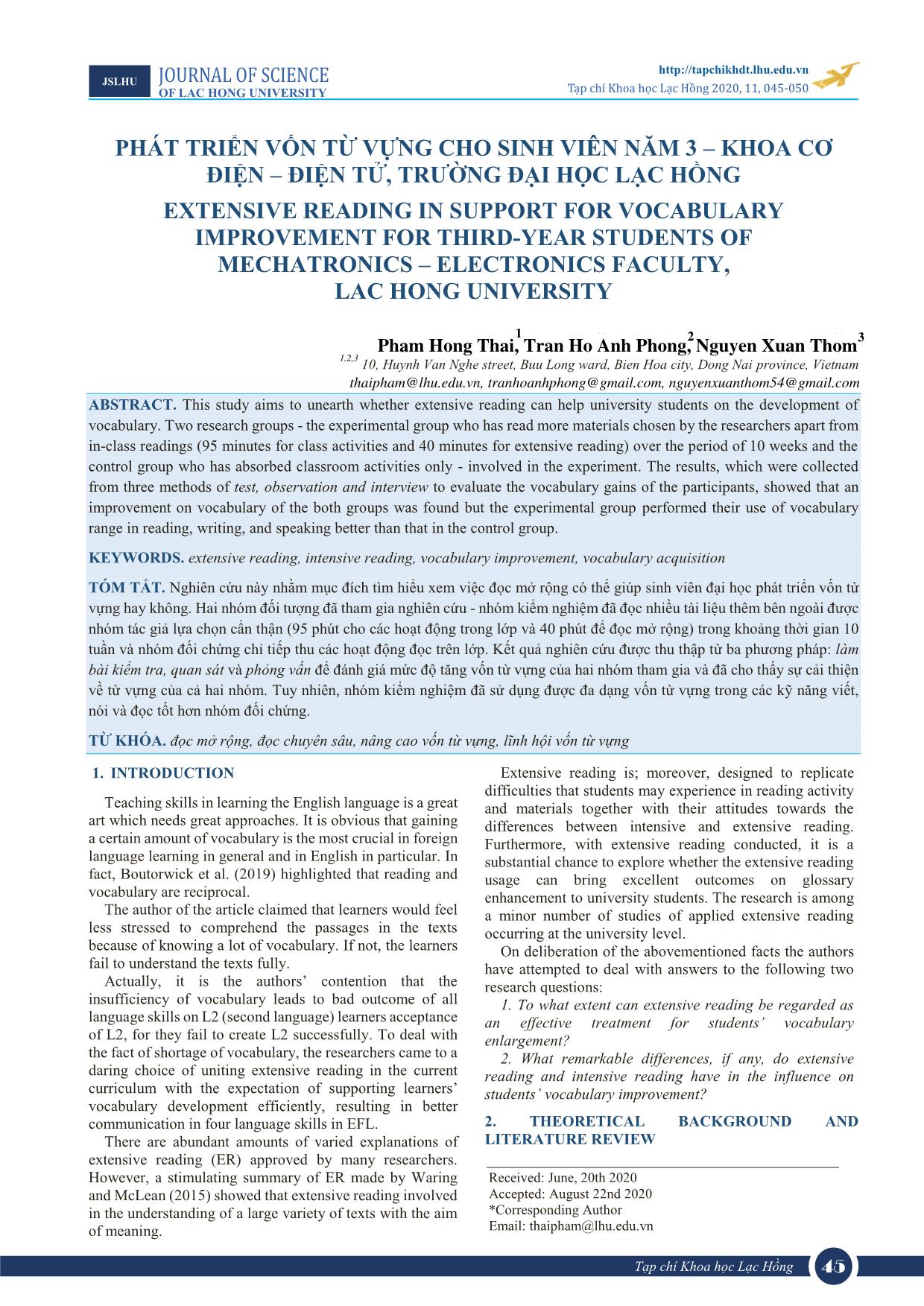
Trang 1
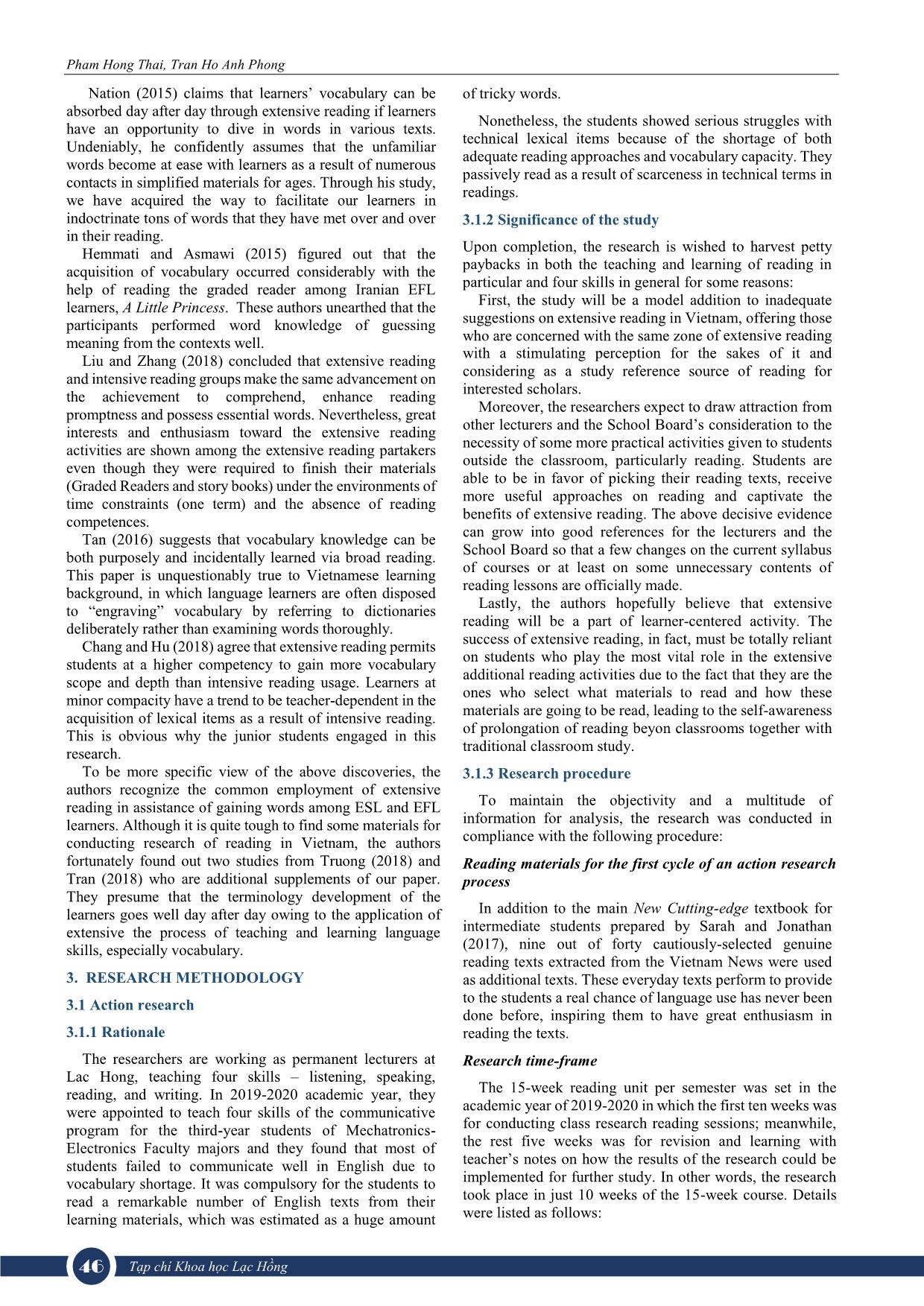
Trang 2
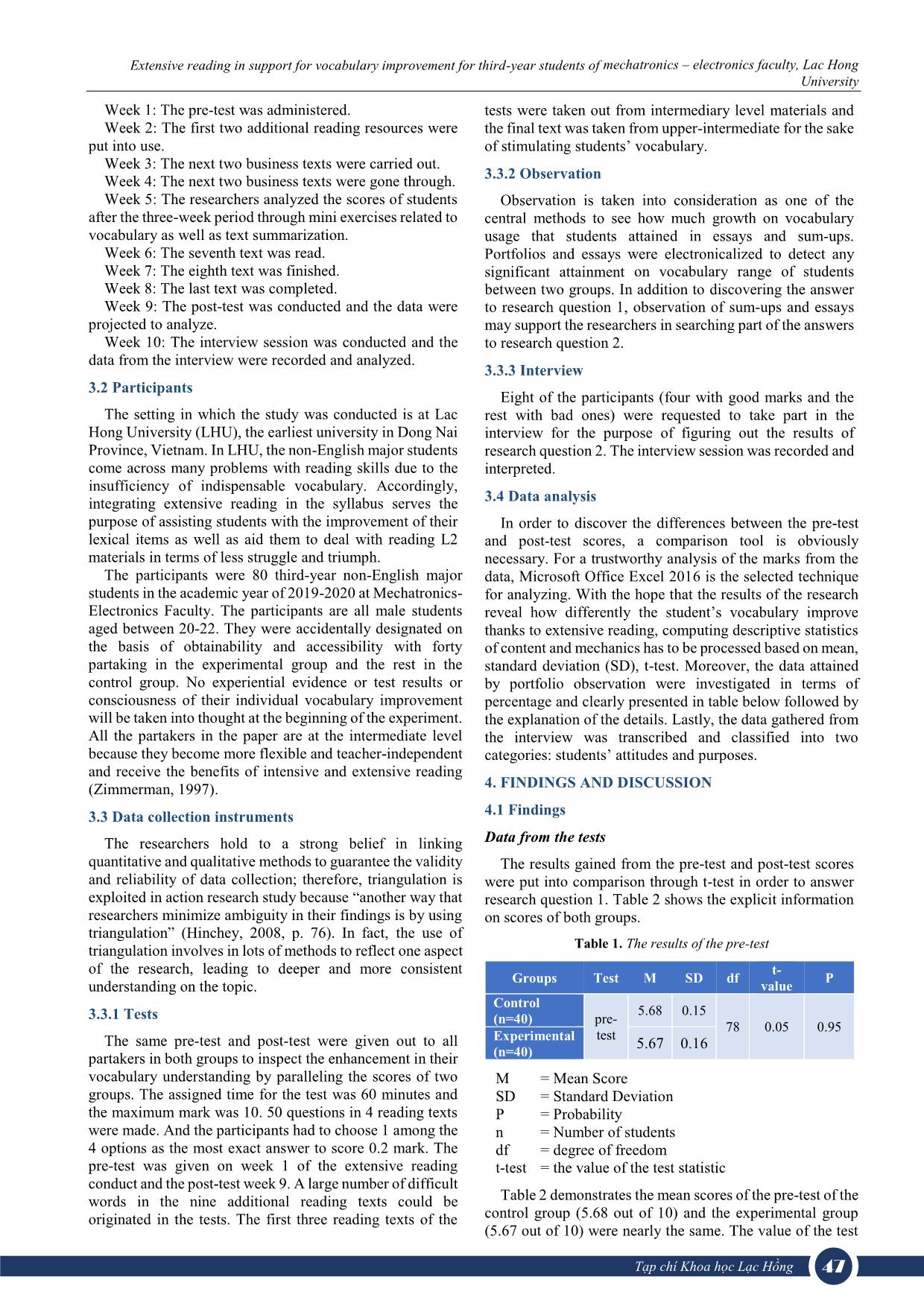
Trang 3
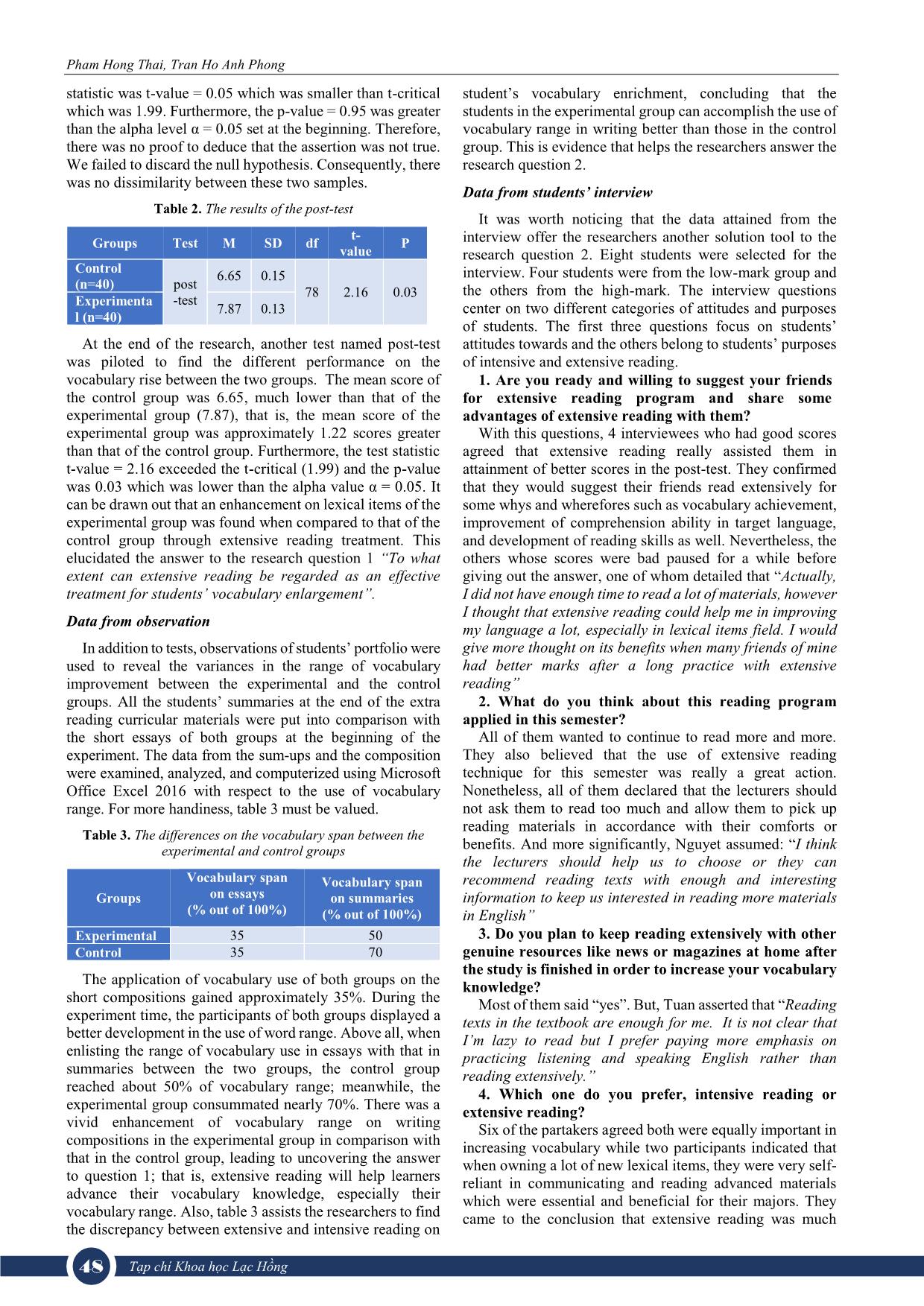
Trang 4
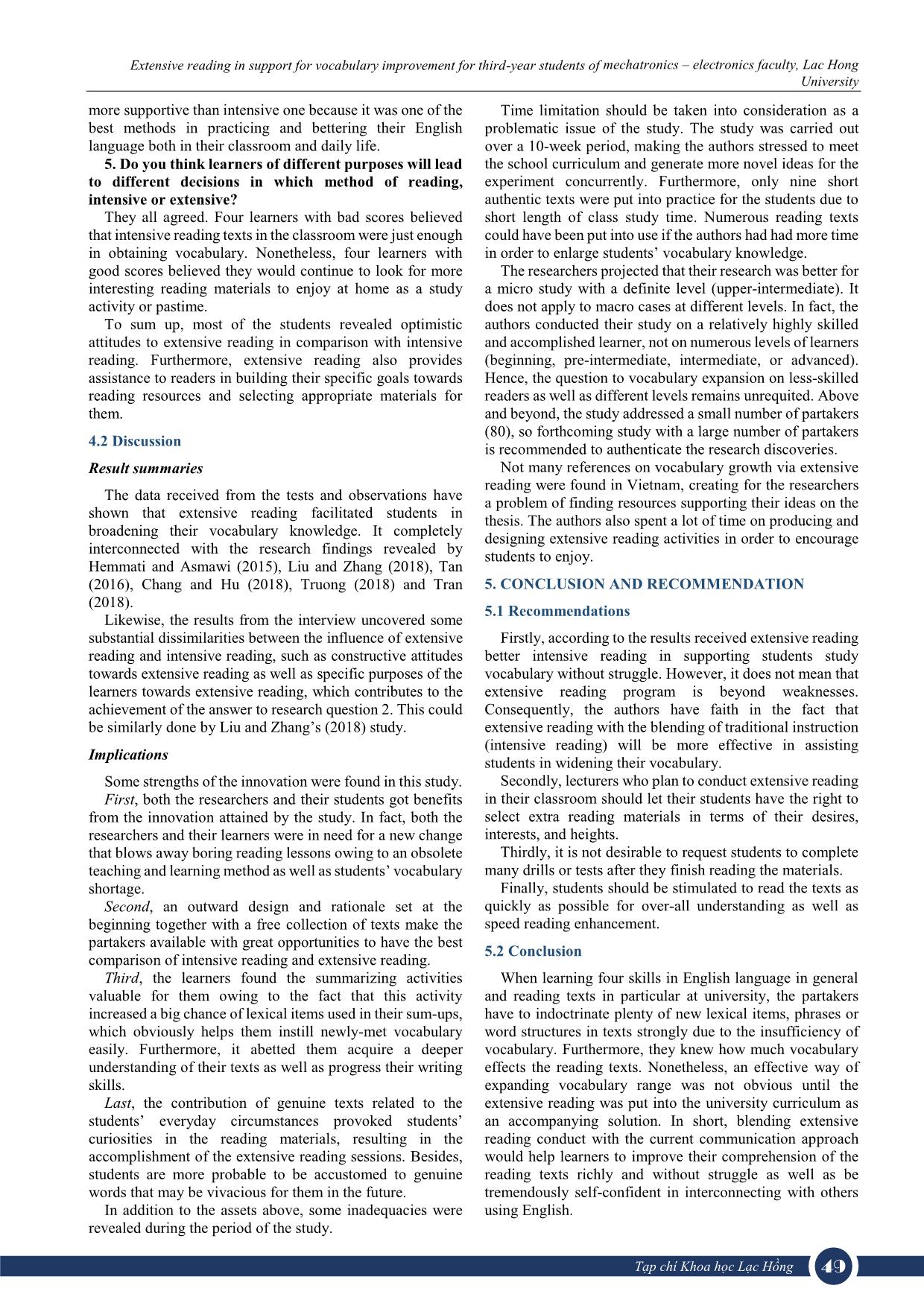
Trang 5
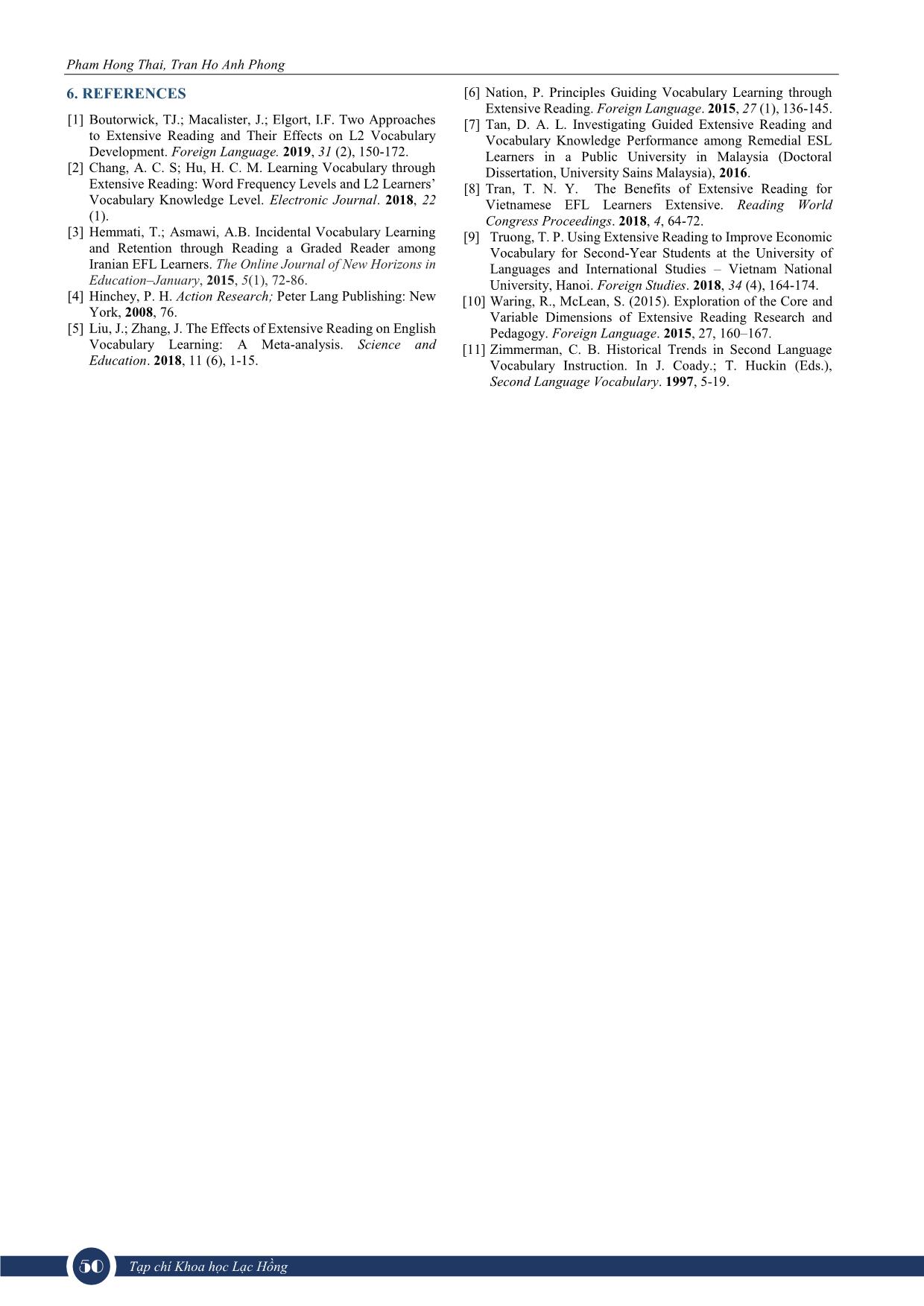
Trang 6
Tóm tắt nội dung tài liệu: Phát triển vốn từ vựng cho sinh viên năm 3 - khoa cơ điện - điện tử, trường Đại học Lạc Hồng
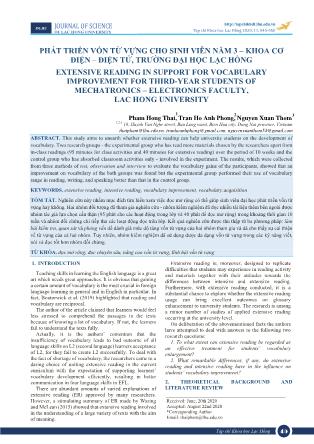
Tạp chí Khoa học Lạc Hồng 45 Vo Thi Thanh Lan, Nguyen Minh Phu As seen from the findings, both of the two parties assert that the unavoidable existence of reticence cannot merely attribute to students’ cultural background, attitude, anxiety, and interests. Sources of reticence are also found to emerge from teachers’ methodology, dominance, and the imposition of language use. Under the time constraints, this study was conducted with small scopes of questionnaire and interview methods. With the desire of overcoming this limitation, the researchers are going to conduct action research to test whether the aforementioned recommendations are practical through students’ reflection during a semester. Enrolling students in an online discussing forum so that students can exchange ideas about what happens in their classrooms is a feasible way for teachers to re-evaluate their teaching styles and professionalism as well as to develop the best practices being adopted in the future. 4. REFERENCES [1] Bao D. Voices of the Reticent? Getting Inside Views of Vietnamese Secondary Students on Learning. In: Cortazzi M., Jin L. (eds) Researching Cultures of Learning. Palgrave Macmillan, London, 2013. [2] Dornyei, Z. Questionnaires in Second Language Research: Construction, Administration, and Processing. Mahwah, New Jersey: Lawrence Erlbaum Associates Publishers, 2003. [3] Dwyer, E., & Heller-Murphy, A. Japanese learners in speaking classes, 1996. [4] Fang-yu, C. The Causes of Learners' Reticence and Passivity in English Classrooms in Taiwan. Journal of Asia TEFL, 2011, 8(1). [5] Flowerdew, J., & Miller, L. Chinese lecturers’ perceptions, problems and strategies in lecturing in English to Chinese- speaking students. RELC, 2000, 31, 116-138. [6] Jarvis, M. The psychology of effective teaching and learning. Cheltenham, UK: Nelson Thornes, 2005. [7] Keaten, J. A., & Kelly, L. Reticence: An affirmation and revision. Communication Education, 2000, 49, 165–177. [8] Kiasi, M. A., & Hemmati, F. The importance of ‘teacher talk’in teaching EFL writing. Porta Linguarum, 2014, 22: 95-108. []. [9] Lee, W., & Ng, S. Reducing student reticence through teacher interaction strategy. ELT Journal, 2010, 64(3), 302- 313. [10] Li, H., & Liu, Y. A Brief Study of Reticence in ESL Class. Theory and Practice in Language Studies. 2011, 1(8), 961- 965. doi:10.4304/tpls.1.8.961-965 [11] Liu, J. Asian students’ classroom communication patterns in U. S. universities – An epic perspective. The United States: Greenwood Publishing Group, 2001. [12] Liu, M., & Jackson, J. Reticence and anxiety in oral English lessons: A case study in China. In Researching Chinese Learners, 2011, 119-137. Palgrave Macmillan, London. [13] Mousapour Negari, G., & Nabavizadeh, Z. An investigation into reticence and vocabulary knowledge of Iranian EFL learners. Iranian Journal of Applied Language Studies, 2012, 4(1), 81-106. [14] Phillips, G. M. Communication incompetencies: A theory of training oral performance behavior. Carbondale: Southern Illinois University Press, 1991. [15] Riasati, M. J. EFL learners’ perception of factors influencing willingness to speak English in language classrooms: A qualitative study. World Applied Sciences Journal, 2012, 17(10), 1287-1297. [16] Rodríguez, C. A. V., & Arellano, R. F. A. Teacher talk and student talk, who is in charge? A study on classroom discourse and pedagogical interactions. The LEC Journal, 2018, 1-25. [17] Seidman, I. E. Interviewing as qualitative research: A guide for researchers in education and social sciences. Thousand Oaks, CA: Teachers College Press, 1991. [18] Strahan, D. Successful teachers develop academic momentum with reluctant students. Middle School Journal, 2008, 39(5), 4-12. [19] Syed, R. Reticence among Jazan University students: A Critical Analysis. Arab World English Journal (AWEJ), 2015, 6(4), 218-230. JSLHU JOURNAL OF SCIENCE OF LAC HONG UNIVERSITY www.jslhu.edu.vn Tạp chí Khoa học Lạc Hồng 2020, 6, 1-6 PHÁT TRIỂN VỐN TỪ VỰNG CHO SINH VIÊN NĂM 3 – KHOA CƠ ĐIỆN – ĐIỆN TỬ, TRƯỜNG ĐẠI HỌC LẠC HỒNG EXTENSIVE READING IN SUPPORT FOR VOCABULARY IMPROVEMENT FOR THIRD-YEAR STUDENTS OF MECHATRONICS – ELECTRONICS FACULTY, LAC HONG UNIVERSITY Pham Hong Thai1,a*, Tran Ho Anh Phong2,b 110, Huynh Van Nghe street, Buu Long ward, Bien Hoa city, Dong Nai province, Vietnam 210, Huynh Van Nghe street, Buu Long ward, Bien Hoa city, Dong Nai province, Vietnam athaipham@lhu.edu.vn, btranhoanhphong@gmail.com ABSTRACT. This study aims to unearth whether extensive reading can help university students on the development of vocabulary. Two research groups - the experimental group who has read more materials chosen by the researchers apart from in-class readings (95 minutes for class activities and 40 minutes for extensive reading) over the period of 10 weeks and the control group who has absorbed classroom activities only - involved in the experiment. The results, which were collected from three methods of test, observation and interview to evaluate the vocabulary gains of the participants, showed that an improvement on vocabulary of the both groups was found but the experimental group performed their use of vocabulary range in reading, writing, and speaking better than that in the control group. KEYWORDS. extensive reading, intensive reading, vocabulary improvement, vocabulary acquisition TÓM TẮT. Nghiên cứu này nhằm mục đích tìm hiểu xem việc đọc mở rộng có thể giúp sinh viên đại học phát triển vốn từ vựng hay không. Hai nhóm đối tượng đã tham gia nghiên cứu - nhóm kiểm nghiệm đã đọc nhiều tài liệu thêm bên ngoài được nhóm tác giả lựa chọn cẩn thận (95 phút cho các hoạt động trong lớp và 40 phút để đọc mở rộng) trong khoảng thời gian 10 tuần và nhóm đối chứng chỉ tiếp thu các hoạt động đọc trên lớp. Kết quả nghiên cứu đượ ... agreed. Four learners with bad scores believed that intensive reading texts in the classroom were just enough in obtaining vocabulary. Nonetheless, four learners with good scores believed they would continue to look for more interesting reading materials to enjoy at home as a study activity or pastime. To sum up, most of the students revealed optimistic attitudes to extensive reading in comparison with intensive reading. Furthermore, extensive reading also provides assistance to readers in building their specific goals towards reading resources and selecting appropriate materials for them. 4.2 Discussion Result summaries The data received from the tests and observations have shown that extensive reading facilitated students in broadening their vocabulary knowledge. It completely interconnected with the research findings revealed by Hemmati and Asmawi (2015), Liu and Zhang (2018), Tan (2016), Chang and Hu (2018), Truong (2018) and Tran (2018). Likewise, the results from the interview uncovered some substantial dissimilarities between the influence of extensive reading and intensive reading, such as constructive attitudes towards extensive reading as well as specific purposes of the learners towards extensive reading, which contributes to the achievement of the answer to research question 2. This could be similarly done by Liu and Zhang’s (2018) study. Implications Some strengths of the innovation were found in this study. First, both the researchers and their students got benefits from the innovation attained by the study. In fact, both the researchers and their learners were in need for a new change that blows away boring reading lessons owing to an obsolete teaching and learning method as well as students’ vocabulary shortage. Second, an outward design and rationale set at the beginning together with a free collection of texts make the partakers available with great opportunities to have the best comparison of intensive reading and extensive reading. Third, the learners found the summarizing activities valuable for them owing to the fact that this activity increased a big chance of lexical items used in their sum-ups, which obviously helps them instill newly-met vocabulary easily. Furthermore, it abetted them acquire a deeper understanding of their texts as well as progress their writing skills. Last, the contribution of genuine texts related to the students’ everyday circumstances provoked students’ curiosities in the reading materials, resulting in the accomplishment of the extensive reading sessions. Besides, students are more probable to be accustomed to genuine words that may be vivacious for them in the future. In addition to the assets above, some inadequacies were revealed during the period of the study. Time limitation should be taken into consideration as a problematic issue of the study. The study was carried out over a 10-week period, making the authors stressed to meet the school curriculum and generate more novel ideas for the experiment concurrently. Furthermore, only nine short authentic texts were put into practice for the students due to short length of class study time. Numerous reading texts could have been put into use if the authors had had more time in order to enlarge students’ vocabulary knowledge. The researchers projected that their research was better for a micro study with a definite level (upper-intermediate). It does not apply to macro cases at different levels. In fact, the authors conducted their study on a relatively highly skilled and accomplished learner, not on numerous levels of learners (beginning, pre-intermediate, intermediate, or advanced). Hence, the question to vocabulary expansion on less-skilled readers as well as different levels remains unrequited. Above and beyond, the study addressed a small number of partakers (80), so forthcoming study with a large number of partakers is recommended to authenticate the research discoveries. Not many references on vocabulary growth via extensive reading were found in Vietnam, creating for the researchers a problem of finding resources supporting their ideas on the thesis. The authors also spent a lot of time on producing and designing extensive reading activities in order to encourage students to enjoy. 5. CONCLUSION AND RECOMMENDATION 5.1 Recommendations Firstly, according to the results received extensive reading better intensive reading in supporting students study vocabulary without struggle. However, it does not mean that extensive reading program is beyond weaknesses. Consequently, the authors have faith in the fact that extensive reading with the blending of traditional instruction (intensive reading) will be more effective in assisting students in widening their vocabulary. Secondly, lecturers who plan to conduct extensive reading in their classroom should let their students have the right to select extra reading materials in terms of their desires, interests, and heights. Thirdly, it is not desirable to request students to complete many drills or tests after they finish reading the materials. Finally, students should be stimulated to read the texts as quickly as possible for over-all understanding as well as speed reading enhancement. 5.2 Conclusion When learning four skills in English language in general and reading texts in particular at university, the partakers have to indoctrinate plenty of new lexical items, phrases or word structures in texts strongly due to the insufficiency of vocabulary. Furthermore, they knew how much vocabulary effects the reading texts. Nonetheless, an effective way of expanding vocabulary range was not obvious until the extensive reading was put into the university curriculum as an accompanying solution. In short, blending extensive reading conduct with the current communication approach would help learners to improve their comprehension of the reading texts richly and without struggle as well as be tremendously self-confident in interconnecting with others using English. Tạp chí Khoa học Lạc Hồng50 Pham Hong Thai, Tran Ho Anh Phong 6. REFERENCES [1] Boutorwick, TJ.; Macalister, J.; Elgort, I.F. Two Approaches to Extensive Reading and Their Effects on L2 Vocabulary Development. Foreign Language. 2019, 31 (2), 150-172. [2] Chang, A. C. S; Hu, H. C. M. Learning Vocabulary through Extensive Reading: Word Frequency Levels and L2 Learners’ Vocabulary Knowledge Level. Electronic Journal. 2018, 22 (1). [3] Hemmati, T.; Asmawi, A.B. Incidental Vocabulary Learning and Retention through Reading a Graded Reader among Iranian EFL Learners. The Online Journal of New Horizons in Education–January, 2015, 5(1), 72-86. [4] Hinchey, P. H. Action Research; Peter Lang Publishing: New York, 2008, 76. [5] Liu, J.; Zhang, J. The Effects of Extensive Reading on English Vocabulary Learning: A Meta-analysis. Science and Education. 2018, 11 (6), 1-15. [6] Nation, P. Principles Guiding Vocabulary Learning through Extensive Reading. Foreign Language. 2015, 27 (1), 136-145. [7] Tan, D. A. L. Investigating Guided Extensive Reading and Vocabulary Knowledge Performance among Remedial ESL Learners in a Public University in Malaysia (Doctoral Dissertation, University Sains Malaysia), 2016. [8] Tran, T. N. Y. The Benefits of Extensive Reading for Vietnamese EFL Learners Extensive. Reading World Congress Proceedings. 2018, 4, 64-72. [9] Truong, T. P. Using Extensive Reading to Improve Economic Vocabulary for Second-Year Students at the University of Languages and International Studies – Vietnam National University, Hanoi. Foreign Studies. 2018, 34 (4), 164-174. [10] Waring, R., McLean, S. (2015). Exploration of the Core and Variable Dimensions of Extensive Reading Research and Pedagogy. Foreign Language. 2015, 27, 160–167. [11] Zimmerman, C. B. Historical Trends in Second Language Vocabulary Instruction. In J. Coady.; T. Huckin (Eds.), Second Language Vocabulary. 1997, 5-19. JSLHU JOURNAL OF SCIENCE OF LAC HONG UNIVERSITY www.jslhu.edu.vn Tạp chí Khoa học Lạc Hồng 20xx, x, xx-zz USING ENGLISH SONGS EFFECTIVELY FOR THE PRACTICE OF PRONUNCIATION IN LAC HONG UNIVERSITY EFL CLASSES SỬ DỤNG BÀI HÁT TIẾNG ANH HIỆU QUẢ TRONG VIỆC LUYỆN TẬP PHÁT ÂM TRONG CÁC LỚP TIẾNG ANH TẠI ĐẠI HỌC LẠC HỒNG Nguyen Duc Duy Tan* Faculty of English Language, Lac Hong University, Vietnam duytan@lhu.edu.vn ABSTRACT. In the context of English as a Foreign Language (EFL) where the exposure to authentic English language is limited, there is always a need of methods of teaching and learning which offer learners sufficient access to communicative practice. Among the problems that arise, issues related to pronunciation really ring the alarm and should be taken into account. There have been existing similar problems in EFL classes at Lac Hong University where students find it hard and unmotivated to learn and improve their pronunciation in general, and the ability to perform sentence in particular. Therefore, a novel approach of using English songs for practising this communicative aspect was used with a hope that this could reflect a sense of effectiveness. Qualitative action research with questionnaires, interviews and class observations was carried out with the participation of 100 learners from 4 classes where they were presented English songs in the periods of pronunciation practice. The result was positive – the level of engagement and performance strongly increased. Moreover, this approach was also proved to be an interesting and effective way of self-study and long-life study. KEYWORDS. English pronunciation, sentence stress, English songs, innovation, engagement TÓM TẮT. Trong bối cảnh tiếng Anh được sử dụng như một ngoại ngữ với việc người học ít có cơ hội tiếp xúc với tiếng Anh thực tế, cần có một phương pháp cho việc dạy và học tiếng Anh mang lại cho người học cơ hội tiếp cận với tiếng Anh giao tiếp thực tế. Trong số những vấn đề khó khăn mà người học thường gặp phải, vấn đề liên quan đến phát âm thể hiện tính nghiêm trọng đáng kể và cần phải có những giải pháp hiệu quả. Trong các lớp tiếng Anh tại Đại học Lạc Hồng, sinh viên dường như ít hứng thú trong các giờ phát âm qua đó hạn chế việc phát triển kỹ năng quan trọng này, đặc biệt là khả năng thể hiện trọng âm và ngữ điệu. Do đó, những phương pháp tiếp cận mới cần được áp dụng nhằm tăng hiệu quả của các giờ luyện tập phát âm và trong số đó việc sử dụng bài hát tiếng Anh có thể thỏa mãn yêu cầu này. Một nghiên cứu hành động trên 100 sinh viên từ 4 lớp học với phiếu khảo sát, phỏng vấn và quan sát lớp học đã được thực hiện với mục đích làm rõ sự tương tác của sinh viên với bài hát tiếng Anh trong những giờ luyện tập cùng với mức độ hiệu quả mà phương pháp này mang lại. Kết quả cho thấy sự khả quan khi mức độ tương tác của sinh viên khá cao và khả năng thể hiện trọng âm và ngữ điệu nói riêng, cũng như kỹ năng phát âm nói chung cũng được cải thiện. Hơn nữa, kết quả còn cho thấy việc sử dụng bài hát tiếng Anh còn là một phương pháp tự học thú vị và hiệu quả. TỪ KHÓA. phát âm tiếng Anh, trọng âm, bài hát tiếng Anh, cải tiến, tương tác 1. INTRODUCTION The practice of teaching and learning English in a particular context is often characterised with its own features suitable to the social reality and cultural identity. Among the contexts which are generally common, English as a Foreign Language (EFL) seems to draw much attention from English language experts, language teachers and learners as that context, which is typical in many of Asian countries, especially Vietnam, reflects several challenges to both instructions and acquisitions and individuals who, directly and indirectly, get involved in these. One of the biggest perceived challenges is very little level of authentic English exposure, as defined as the real English used widely and similarly to how it is present in native speakers’ communication. This results in a high dependence on course books and teacher instructions which are demanded to model a real world to learners where they can actually use the language, e.g. communicative language teaching method. However, the methods of this kind are not ultimately and thoroughly across the country’s secondary schools as they require major changes, difficult and expensive, in the whole system of education and testing. Therefore, a big shift in both teaching instructions and learning strategies, e.g. focus on speaking ability and phonological range and control, at college seems very demotivating. Students at Faculty of English Language (FoEL), Lac Hong University (LHU) are currently taking ESP courses; particularly, English courses for business communication as working for foreign companies. Typically, the students at FoEL in particular, and LHU in general are with a low level of prior English knowledge; in other words, they do not have a good foundation of most of language aspects, especially pronunciation. Also, the school is located in an area with very little authentic English which students can have access to as very few foreigners come to live and work, not mention the unfavourable rural areas where a big proportion of students are originated. This could cause the students to attempt vulnerably to acquire the communicative competence, often broken down as grammatical competence, strategic competence, social-linguistic competence and discourse competence which ideally act in a close relationship for a full formation of language proficiency. For Received: June, 13th 2020 Accepted: September 08th 2020 *Corresponding Author Email: duytan@lhu.edu.vn
File đính kèm:
 phat_trien_von_tu_vung_cho_sinh_vien_nam_3_khoa_co_dien_dien.pdf
phat_trien_von_tu_vung_cho_sinh_vien_nam_3_khoa_co_dien_dien.pdf

